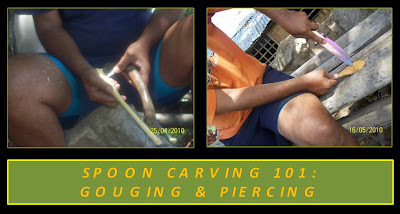CARVING A WOODEN SPOON is valued highly in bushcraft and survival. In temperate zones where there is a winter season, extreme cold can be brutal and metal would adhere to bare skin and it is rather painful to remove that from your hand unless you have an elastic skin. A lot of Filipino soldiers learned this lesson the hard way when they were assigned in the frigid winters of the Korean peninsula during the 1950-53 Korean War.
In the tropics, a wooden spoon is also very important. Let's say you are stranded in the jungle and you lost all your belongings except your safety matches and your Swiss knife. You can cook, yes, but you can't rely on any stick to stir your food much less your hand to eat your food with. Eating directly from the hand may expose you to tropical diseases and you don't want to take those chances, would you?
Most likely you have to make a spoon. Tool making is an art and carving a spoon from wood is a skill that every bushcrafter worth his salt should learn and know. For starters, select any soft wood as your material for a spoon. Any sturdy cutting tool would do. In some photos, I am using a throwing 'hawk. I am into wood carving for sometime and using a knife or a hatchet is so natural for me that I couldn't care less which one I use. For beginners, a knife is best.
Always observe safety precaution. Wear a pair of gloves and place a piece of thick clothe or leather to cover your legs for protection. As you can see, I am wearing without any protection in the photos and do not imitate these. One thing to remember though: you have to develop a bond with the blade and become skilled in its use but that is another chapter – long and painful.
Cut the best part and then slice the wood according to the style of the spoon you have blueprinted in your head. If you are doing this in the comforts of your home, draw a pattern on a piece of paper and follow the specs. Chop the sides where you would want your handle to be carved from and retain the part where you will make your spoon head. Then whittle it down until it is thin enough to start scraping the wood.
Whittle and scrape. Whittle and scrape. Whittle and scrape. It is like that else you will commit an error in judgment that may cause your spoon with a flaw. Unlike paper and pencil you cannot undo what you have erred in doing when carving a wood. If you're really very good you could, however, improvise on the flaw and make it look natural. Misjudgments happen. Otherwise, be patient. Whittle and scrape. Check the lines and curves always. Whittle and scrape.
The most difficult part to make would be the spoon head. It is the part where it would hold soup. A spoon that could not hold soup is not a spoon but a back scratcher. A good back scratcher though. Pierce the head with the point of your knife and lever. Repeat it many times. You gouge out whatever excess wood until you have created a concave – a depression. Scrape away the excess wood and deepen the depression. Scrape, scrape, scrape.
You will now have a rough spoon. Most people finish their spoon with a curved knife. A spoon knife. But we don't have that. Improvise. A broken piece of bottle is a good alternative. Use it to scrape away the rough edges not too hard as it may chip away. Scrape away and arrive at a finished look. Feel the grain of the wood for any bulges and concentrate your glass on that part until all surfaces are even. Rub it with fine sand or sand pebble if you are outdoors else use a fine sandpaper.
Most people like their spoon in their natural state but if you would want your spoon to last for years, coat it with varnish. You will now have a spoon to boast of. Make another one and another until you will become versed with the process. A process that come in handy later when you are in a real-life survival situation.
Happy eating.
Document done in OpenOffice 2.1 Writer







































4 comments:
Wow. Now that's what you call a hand-made wooden spoon. Great post, so unique. Hope you can check out my blog too. Cheers!;-)
It is unique because this blog is the only site dedicated to Philippine bushcraft & survival. Thank you for the visit and comments. Will look forward to visit your site soon.
Thanks. I'll be following your blog. Cheers! ;-)
Hi buddy, great blog, Al
Post a Comment